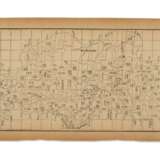ID 627599
Lot 110 | Complete Map of Tibet
Valeur estimée
$ 700 – 1 000
Scarce and important map of Tibet, lying in grids, overlaid by oblique meridian lines, marked with longitude starting from 18° on the right edge to 45° to the left. In the map, Tibet traverses 27 degrees of longitude, six degrees more than the data in modern maps, from 78°E to 99°E (Chan). This map is almost identical with the Complete Map of Tibet in the first volume of Xizang Tukao (An Illustrated Research Report on Tibet; see lot 109 in the current sale) edited by Huang Peiqiao and published in 1894. The differences between these two maps include: firstly, the map in Xizang Tukao is divided into four separate pages, while the present lot preserves the continuous scene, which is probably closer to the initial draft drawn out by the copyist Han Shen; secondly, the title of the map on the right side of the present lot is moved to a single title page in the book prior to the map, and the two-line inscription on the left side of the present lot with information of the authors are removed in the book; the name of the copyist, Han Shen (or Han Daling) is instead mentioned by Huang Peiqiao in the text following the map in the book; and thirdly, some details are different within the two maps, including two longitudes, the first character of the name of a lake at the top (one uses zai and the other jia), and that the scale (the side of grid equals to 100,000 meters) of the map appearing in the map in book but not in the present lot. As Huang Peiqiao stated, the final version of the map in book was achieved through multiple revised copies; it is likely that the present lot is one of the earlier printed drafts. Different from the book that has been widely circulated and has multiple extant copies, drafts of the map like the present lot that reveals the working process of cartography is unique and extremely rare. Although scientific maps of Tibet were already produced during Kangxi period, those maps were not circulated outside of the palace, and thus the maps produced by Huang Peiqiao were the first scientific maps of Tibet accessible to the public. References: Libby Lai-Pik Chan, East Meets West - Maritime Silk Routes in the 13th-18th Centuries (2016).
Woodblock map of Tibet, ink printed on paper, 155 x 460 mm to neat lines on 230 x 585 mm sheet. (A bit yellowed, edges fragile with some marginal tears).
Exhibited: "The World on Paper: From Square to Sphericity," Hong Kong Maritime Museum, December 2019 to March 2020.
Please note that this lot is subject to an import tariff. If the buyer instructs Christie’s to arrange shipping of the lot to a foreign address, the buyer will not be required to pay the import tariff. If the buyer instructs Christie’s to arrange shipping of the lot to a domestic address, if the buyer collects the property in person, or if the buyer arranges their own shipping (whether domestically or internationally), the buyer will be required to pay the import tariff. Please contact Post Sale Services on +1 212 636 2650 prior to bidding for more information.
| Artiste: | William Shakespeare (1564 - 1616) |
|---|---|
| Technique appliquée: | Crayon |
| Artiste: | William Shakespeare (1564 - 1616) |
|---|---|
| Technique appliquée: | Crayon |
| Adresse de l'enchère |
CHRISTIE'S 8 King Street, St. James's SW1Y 6QT London Royaume-Uni | |
|---|---|---|
| Aperçu |
| |
| Téléphone | +44 (0)20 7839 9060 | |
| Commission | see on Website | |
| Conditions d'utilisation | Conditions d'utilisation |












